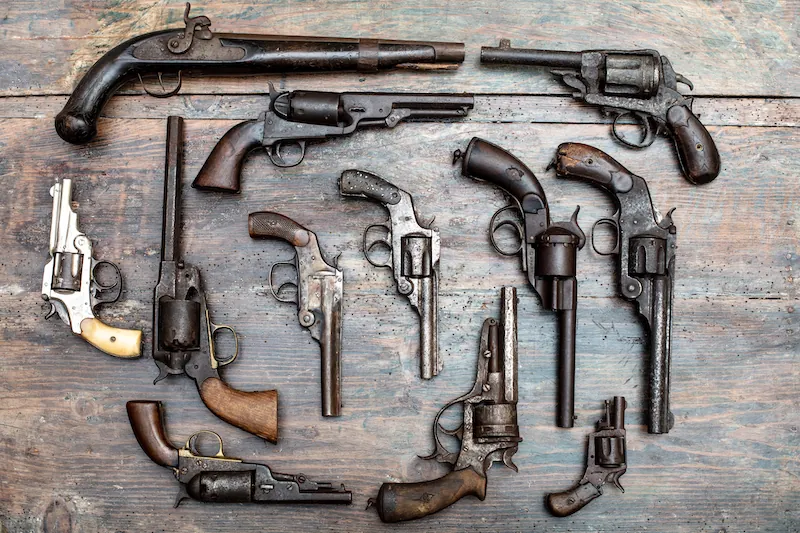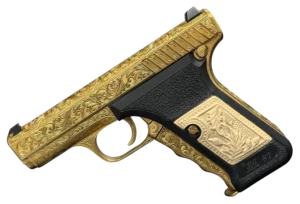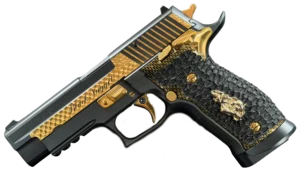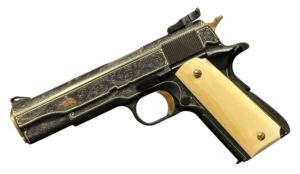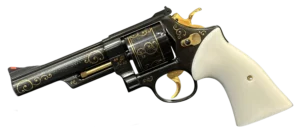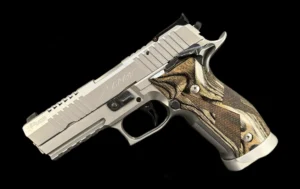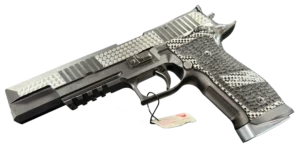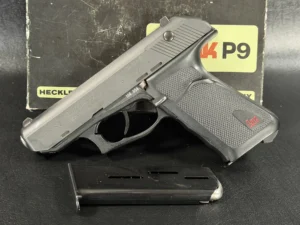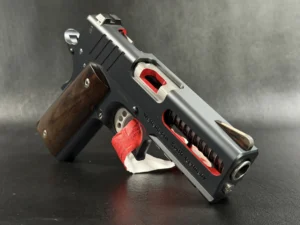Key Takeaways:
- There’s a big difference between owning guns and collecting them: Buying a bunch of firearms because they look cool or shoot well? That’s fine—valid. But collecting? That’s more like curating a museum. It’s about the story behind each piece, the history it carries, and how it fits into the bigger picture you’re trying to build.
- Knowledge isn’t optional—it’s your best defense: This hobby rewards the curious and punishes the careless. If you skip the research, you’ll overpay, buy junk, or miss out on a once-in-a-lifetime find. Get the books—Lurk in the forums. Ask dumb questions. It’s how everyone starts.
- It’s not about having the biggest or most expensive collection—it’s about what it means to you: Whether you’re chasing ultra-rare Johnson rifles or just hanging onto Grandpa’s deer gun, your collection doesn’t need to impress anyone but you. If it tells a story you care about, you’re doing it right.
Let’s be honest—firearm collecting isn’t just about owning guns. If it were, we’d all stock up on whatever’s cheap at the local shop and call it a day.
But that’s not what this is about.
This is about chasing stories. It’s about holding a piece of history in your hands and wondering whose fingerprints it carried a hundred years ago. Whether you’re just getting started or you’ve already got a few safes’ worth of steel and walnut, collecting firearms is a strange, wonderful rabbit hole that goes deeper the longer you stay in it.
So, how do you make sense of it all? And more importantly, how do you make it meaningful?
Let’s dig in.
Collection vs. Accumulation: Yes, There’s a Difference
This might ruffle a few feathers, but there’s a big difference between collecting and just…accumulating.
Accumulation is when you buy whatever catches your eye. A Glock here, a surplus Mosin there, maybe that wild-looking bullpup just because it feels like something out of a sci-fi movie. Nothing wrong with that—but it’s kind of like throwing paint at a canvas and calling it abstract art.
Collecting, though, is a bit more intentional. You’re not just grabbing guns—you’re telling a story. Maybe it’s a war story. Or innovation. Or your family. Or some actor who looked ridiculously cool with a lever-action on screen.
Here are a few common themes that tend to pop up:
- Historical Significance: Think Civil War rifles, WWII carbines, Cold War-era AKs. Guns that shaped history—or at least witnessed it.
- Rare Pieces: Limited production runs, boutique manufacturers, or oddball mechanisms that never really caught on.
- Obsolete Tech: Rifles with weird triggers, strange feeding systems, or bygone calibers. A niche, but a fun one.
- Pop Culture Icons: The Dirty Harry .44, the Die Hard Beretta, anything Clint Eastwood ever touched.
- Sentimental Guns: Grandpa’s shotgun, the .22 you learned to shoot with, your dad’s old deer rifle.
- Investment Focused: Buying guns with an eye on value appreciation. This one’s tricky—you need knowledge, timing, and a bit of luck.
First, Know the Law (Yes, the Boring Part)
Before you buy your first collectible or drop a few grand on a rare bolt-action, hit the books—or at least bookmark a few state websites.
Gun laws are weird. They vary wildly, not just from state to state, but sometimes town to town. And the last thing you want is to accidentally violate a federal law because you didn’t know that short-barreled rifle you found in Grandpa’s attic required a tax stamp.
Quick rundown:
- The NFA (National Firearms Act): Covers full-autos, suppressors, short-barreled rifles, and shotguns. Want one of those? Get ready for paperwork, background checks, and a $200 tax stamp.
- Curios & Relics License (Type 03 FFL): If you’re serious about collecting older firearms (50+ years old), this is worth looking into. It lets you buy eligible guns across state lines without going through a standard FFL. However, it does come with strings attached—record-keeping, inspections, etc.
Bottom line? Don’t skip the legal homework. Owning cool stuff isn’t worth a federal headache.
Gear That Makes the Hobby Better (and Safer)
Once you start building a collection, you’ll realize that owning the guns is only part of the picture. Taking care of them? That’s where the real pride kicks in.
Here’s what you’ll want:
- A Solid Safe: Fire-rated, water-resistant, and bolted down. Bonus points if it has alarms. These rifles aren’t just toys—they’re irreplaceable.
- Cleaning Supplies: Get the good stuff. Solvents, oil, bore snakes, lint-free cloths. Especially important for old blued steel or antique finishes that’ll rust if you even look at them wrong.
- Reference Books: Whether it’s the Blue Book of Gun Values or obscure manufacturer catalogs from the ’40s, information is half the battle.
- Display Pieces: Not a must, but let’s be real—if you’ve got a rare Garand or a pristine 19th-century lever-action, why not show it off?
Why So Many Collectors Obsess Over Rifles
There’s just something about rifles. The weight. The wood. The history is etched into every dent in the stock.
Maybe it’s the fact that rifles feel like they’ve seen more and carried farther. Been through hell and back. That’s probably why so many collections start—or end—with them.
Here’s how some collectors think about rifle condition:
- Pristine Examples: Basically, museum pieces. You don’t shoot these. You show them off and maybe whisper “wow” every time you walk by.
- “Shoot Once a Year on Sunday” Rifles: Lightly used, but still solid. Worth taking to the range for special occasions. Respect them, but enjoy them.
- Well-Worn Workhorses: Affordable, approachable, and full of character. They’ve seen things. Maybe not worth a fortune, but worth a place in your safe.
Collecting Styles: Vertical or Horizontal?
Most folks fall into one of two camps—somewhere between focused and…well, kind of all over the place.
- Vertical Collections: This means going deep, not wide. One model, every variation. Maybe every serial block. Caliber changes. Year-to-year design tweaks. The whole story in one line.
- Horizontal Collections: Think “Guns of WWII” or “American Rifles of the 19th Century.” You’re grabbing different models that share a theme, not necessarily a lineage.
Neither is “better,” but one will probably feel more like you.
Knowledge Is Everything
This can’t be stressed enough: Know what you’re buying.
Not every seller is honest. Even the most honest ones can be wrong. That rifle may look original, but is the front sight correct for the year? Is the finish too good to be original?
Some essential tools of the trade:
- The Blue Book of Gun Values: Not perfect, but a good starting point.
- Manufacturer Records: Some companies (especially Colt, Winchester, and Smith & Wesson) offer letter services to verify serials and production details.
- Collector Forums: Interestingly, some of the best information can be found in 2005-era forum threads buried four pages deep on obscure websites. Spend some time lurking. You’ll learn a lot.
Don’t Get Burned: Buy With Eyes Wide Open
Here’s what to look for when buying:
- Condition: Check for matching wear. A minty barrel on a worn stock? Red flag. Screws that look like a pocketknife has mauled them? Walk away.
- Authenticity: Be cautious with “restored” or “arsenal refinished” rifles. Some are legit. Others are franken-guns with replacement parts and fake stamps.
- Functionality: Even if you don’t plan to shoot it, have it inspected by a gunsmith. You’d be surprised how many collectible guns are ticking time bombs—or just don’t work.
Rare Rifles Worth Knowing (and Maybe Dreaming About)
If you’re aiming high, here are five rifles that tend to live on collectors’ wish lists:
- M1941 Johnson Rifle: Weird rotating bolt, limited WWII use, and a whole lot of mythos. Only a few hundred survived. If you find one, cherish it.
- Winchester 1895 Lee Straight Pull Straight-pull bolt design from John Browning (because, of course). Rare as anything made in that era and sleek as can be.
- Mannlicher-Schoenauer 1903 Carbine Beautifully built, butter-smooth, and criminally underappreciated. Austrian elegance in a walnut shell.
- Springfield Model 1873 “Trapdoor” The quintessential Indian Wars rifle. Iconic, reliable, and oddly poetic in its simplicity.
- Remington Model 8 Semi-auto from the early 1900s with a long-recoil action that feels like sorcery. Also designed by Browning—because again, of course.
A Couple of Case Studies (Because Theory Only Gets You So Far)
- Winchester Model 70: The classic bolt-action American rifle. Early pre-’64 models are the holy grail. If it’s been refinished or modified? Expect a price dip.
- Remington Model 14-A: Designed by John D. Pedersen (a name worth following, by the way). A collector’s favorite for its unique pump-action design and ammo availability.
Pro tip: Picking a specific designer and chasing their entire portfolio? Incredibly fun. And surprisingly educational.
Final Thoughts: It’s the Story That Counts
Let’s not kid ourselves—this isn’t just a hobby. It’s a kind of time travel. A way to connect with the past, one rifle at a time.
So don’t rush it. Take your time. Ask too many questions. Buy the books before the gun. And don’t worry if your collection doesn’t make sense to anyone else.
If it means something to you, that’s all that matters.
Happy collecting—and may your next find have just the right amount of mystery.
Frequently Asked Questions
Start slow. Pick a theme or a period that interests you—Civil War, WWII, early American hunting rifles, whatever. Then read everything you can. Don’t buy anything just yet. Go to gun shows, talk to people, ask dumb questions (there are no dumb questions). The best collectors didn’t start with deep pockets—they began with curiosity.
Yeah, it can be—but it depends on what you’re buying and where you live. Federal law is one thing, but state and even local laws can throw in weird curveballs. Some guns are classified under the National Firearms Act, which requires paperwork, background checks, and a significant amount of patience. If you’re dealing with ancient stuff, like pre-1899 antiques, those often have fewer restrictions—but again, check your local laws. Seriously.
Ah, the Type 03 FFL. It’s a license you can get from the ATF that lets you buy certain collectible guns (usually 50+ years old) across state lines without going through a dealer every time. It’s not a free pass—you’ve still got to log your purchases and follow the rules—but if you’re serious about collecting, it’s worth looking into. Be prepared to keep accurate records and adhere to the rules.
Depends on the gun—and honestly, it depends on how sentimental or rare it is. Some folks shoot everything they own. Others won’t even rack the bolt on a minty Springfield. A good middle ground? If it’s a well-used shooter with life left in it, take it to the range now and then. If it’s one of those pristine unicorns? Maybe admire it from a safe distance.
Welcome to the world of heartbreak. A lot of rifles look right until you know what “right” means. Learn to identify mismatched serial numbers, post-war refinishes, and reproduction parts. Utilize resources such as manufacturer records or expert forums. And if something feels too cheap or too clean for what it’s supposed to be, it probably is.


